In honor of Women’s History Month, let us talk about the history of educating women. This seems especially apt, because 84% of the overall students here at FIT are female. Historically, the needle-arts have been associated with female gentility and marriageability, which used to be the measure of female success. As women’s work outside of the home became more socially visible, the needle trades remained acceptable businesses for respectable women.
In case you’re curious as to the stats on FIT students, you can find them here:
http://www.fitnyc.edu/1839.asp
Please note that no disrespect is intended towards the male part of the FIT population. We know you’re working hard too!
Needlework has been used to educate young women since at least the middle ages. A young woman might be taught to stitch and spin as soon as she could hold a needle. The author of an early embroidery pattern book, “The Needle’s Excellency“, wrote in his introductory poem,
“Thus hoping that these workes may have this guide
To serve for ornament, and not for pride:
To cherish virtue, banish idlenesse,
For these ends, may this book have good sucesse.”
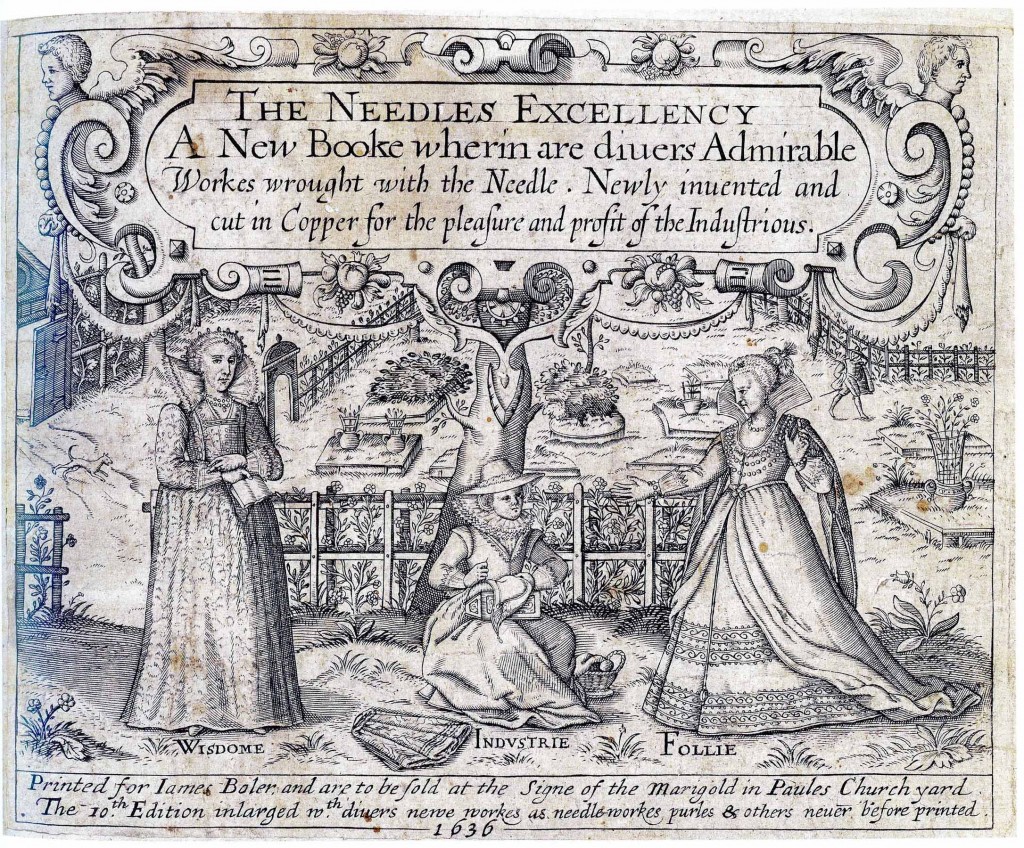
The Needles Excellency
Here pride, vanity, and “Follie” of dress were considered bad characteristics, but that “Industrie” and “Wisdome”, sewing skills, and the thriftiness necessary to run a home, be it hovel or manor, were key life skills.
It wasn’t considered appropriate to teach young women anything other than simple arithmetic, the management skills to run a home (be it hovel or great estate), the thrift to shop for its supplies, the medicinal skills to care for its inhabitants, and the cooking skills to provide meals or supervise those who did. Skill with a needle was considered a form of social polish, and could make a young woman upwardly mobile. By marrying into a better social class than her parents, a woman could improve the finances of her entire family.
There were some notable exceptions to this rule. Noble women might share their brothers’ tutors and learn to read, as well as learn languages such as French, Italian, Latin and Greek. The Este sisters of Italy, Beatrice and Isabella, were noted scholars and patrons of scholars. Thomas More of England was noted throughout Europe for his well educated daughter Meg. All of the Tudors, male and female, read Latin and Greek, spoke multiple languages and read and translated classical texts. Marguerite of Navarre, sister of Francis I of France, was a noted author.
This is the period where girls began to be assigned samplers as part of their education. One of the earliest of these was by Jane Bostocke, and is in the collection of the Victoria and Albert Museum in London.
This piece of work is interesting because it’s designed to practice different embroidery stitches and patterns well enough for the stitcher to be able to apply them to other household textiles, like towels and sheets.
To see more examples of how these stitches were used to decorate household textiles, this book has lots of examples from the home of Bess of Hardwick, a very rich woman from the late 1500s:
Elizabethan Treasures: The Hardwick Hall Textiles
5th Floor, Main Stacks: NK 9244.D47 L48 1998
Here is an example of the sort of samplers (now called “band samplers” because they’re worked in horizontal bands) that were assigned young women at schools or by needlemasters hired in their homes the way tutors were for boys.
This sampler, from the collection in the Metropolitan Museum of Art here in NYC, has embroidered bands of flowers. The patterns in these bands might be used later in a woman’s life to edge sheets or hand-towels. The couple at the top were idealized versions of Adam and Eve, shown in a very simplified form of the Garden of Eden, which was a metaphor for God’s paradise on earth and man’s dominion over it.
By the later seventeenth century (1600s) it had become custom for the maker to “sign” (embroider her name, really) the samplers she made. This is significant for a lot of reasons. It helps us trace schools and styles of design from their origins. It helps secure the dating of the objects. But most importantly, samplers form the most substantial collections of female-made art at many museums. These objects were made by and for women, and they are the first such signed artworks, which allow us to know something of the maker’s life and history.
This tradition came to the Americas with the English settlers of the Massachusetts area in the 1600s. The earliest extant girl’s sampler in American collections is this one, thought to have been worked by Loara Standish, Captain Miles Standish’s daughter around 1653.
This is the earliest known American sampler, and is also one of the earliest to have a verse embroidered onto it.
The Pilgrim Hall museum (where this sampler lives) has an interesting collection of things that early European settlers used in their homes, posted here:
http://www.pilgrimhallmuseum.org/ce_17_century.htm
This one is a lot more faded than the English one at the Metropolitan Museum (pictured above), but it’s style and the type of stitches used are very similar.
Young women in other European cultures also made stitch samplers as part of their education. However, the tradition seems to have been most enthusiastically embraced by English and American schools for young women. Frequently the particular stylistic elements of a group of samplers can be traced back to a particular school in a particular region.
As the 1800s progressed, samplers became less “viney” and more pictoral. American samplers developed some common elements, like display of the alphabet, the maker’s name, the date and some bible quotes. They began to picture houses and animals.
Here is an early 18th century (1700s) sampler. This one, begun by Ealli Crygier of New York in 1734, has some of the floral bands of the older style, but adds in the alphabet, letters, and a very naturalistic bird in the newer style.
Here is one worked by Sara Silsbee of Boston in 1748. The shape is still long and narrow, but letters and figures of Adam and Eve in the Garden of Eden have been added to the decoration. (yes, it’s scanned from an overly-cropped image.)
In 1748, New England was still part of, as Miss Miller declares, “The English Nation”.
This one was embroidered in 1786 by Mary Miller. This is the classic form of this type of sampler, with stylized floral borders, alphabet and verse, placed around potted plants.
And, finally, the figures began to take over. Changes in culture in the nineteenth century changed women’s educations. While needlework remained at the center of the womanly arts, the custom of them working samplers as school assignments fell out of fashion. Here are two later examples, which both have many more figures than the earlier ones above.
This is Lydia Gladding’s work, made in Providence, Rhode Island in October of 1796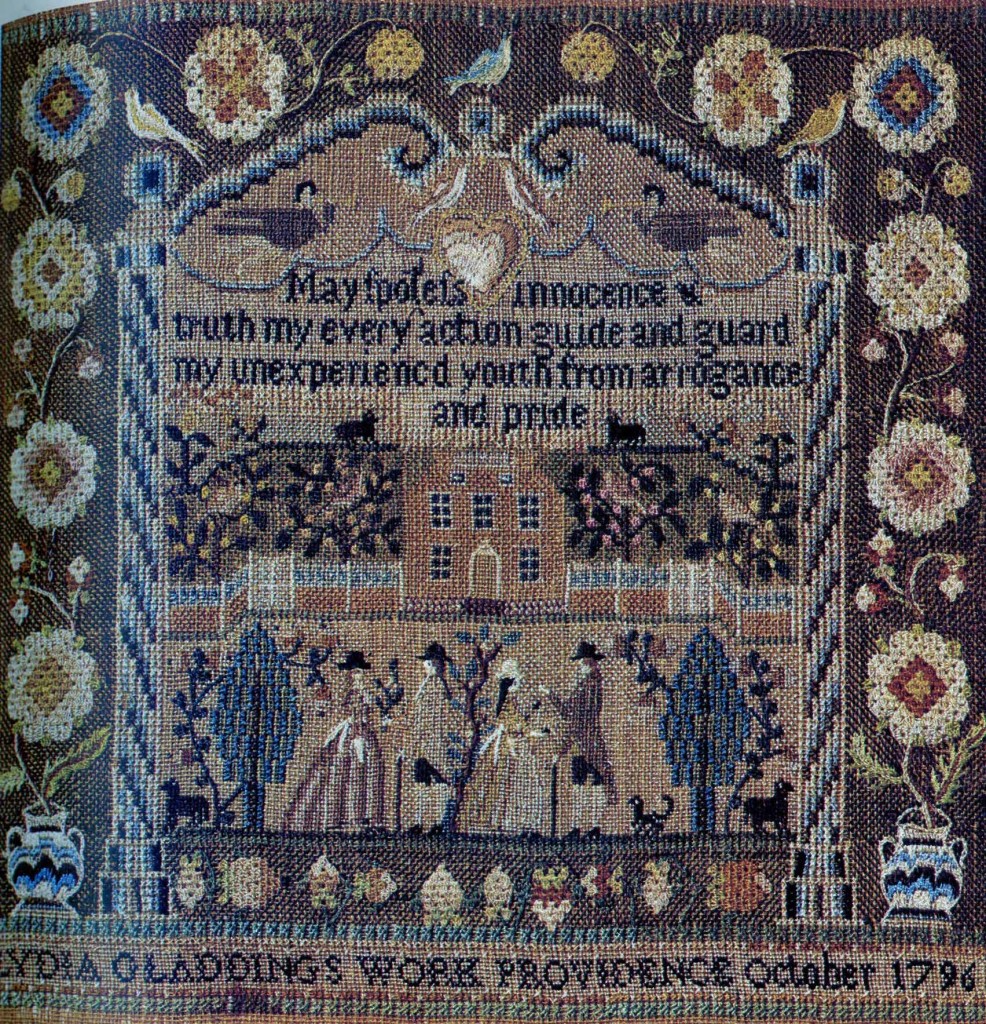
And this lovely work combines both counted alphabet and verse in the center with both naturalistically-drawn and skillfully executed flowers embroidered freely in fine filament silks. This late example of a schoolgirl sampler was created by Anne England in 1820.
The needle arts, such as embroidery and sewing, remain closely associated with girls and women, even if they aren’t included in our education any more. Here at FIT they are still relevant for a lot of different courses. I did one in both the millinery and the eveningwear specialization courses I took here. They can be a useful way of conveying information about stitch names and types especially where a group will be working together on something.
So all those stitch samplers that your draping professor assigns have a long history.
Next installment, coming soon: Respectable women’s work through vocational training to higher education.
Most of the samplers shown in this post can be found in this book:
A Gallery of American Samplers, from the Theodore H. Kapnek Collection
5th floor, in the Main Stacks NK9112 .K78 1978.
Other books in the Gladys Marcus Library that give some background on historic needlework it’s role in women’s education include:
“‘Twixt Art and Nature“, English Embroideries from the Metropolitan Museum of Art, 1580-1700.
5th floor, Main Stacks NK9243.A1 W37 2008
Samplers: Five Centuries of a Gentle Craft
5th floor, Main Stacks NK9106 .S42 1979
5th floor, Main Stacks NK9208 .S73 1991b
5th floor, Main Stacks TT771 .N4813 1994 c. 1 & c. 2
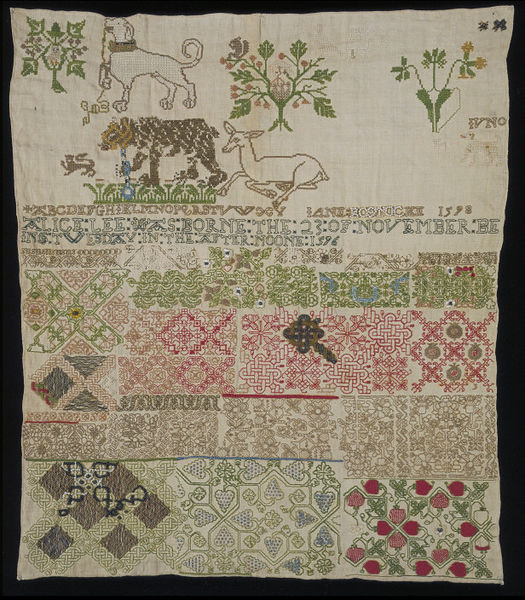
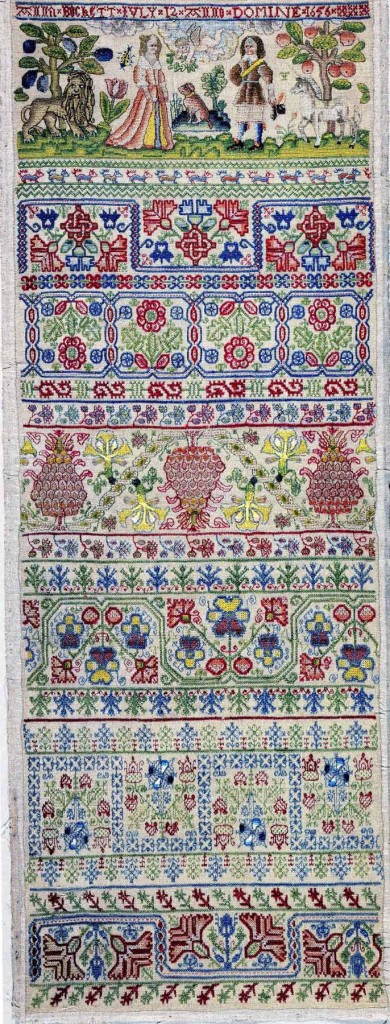

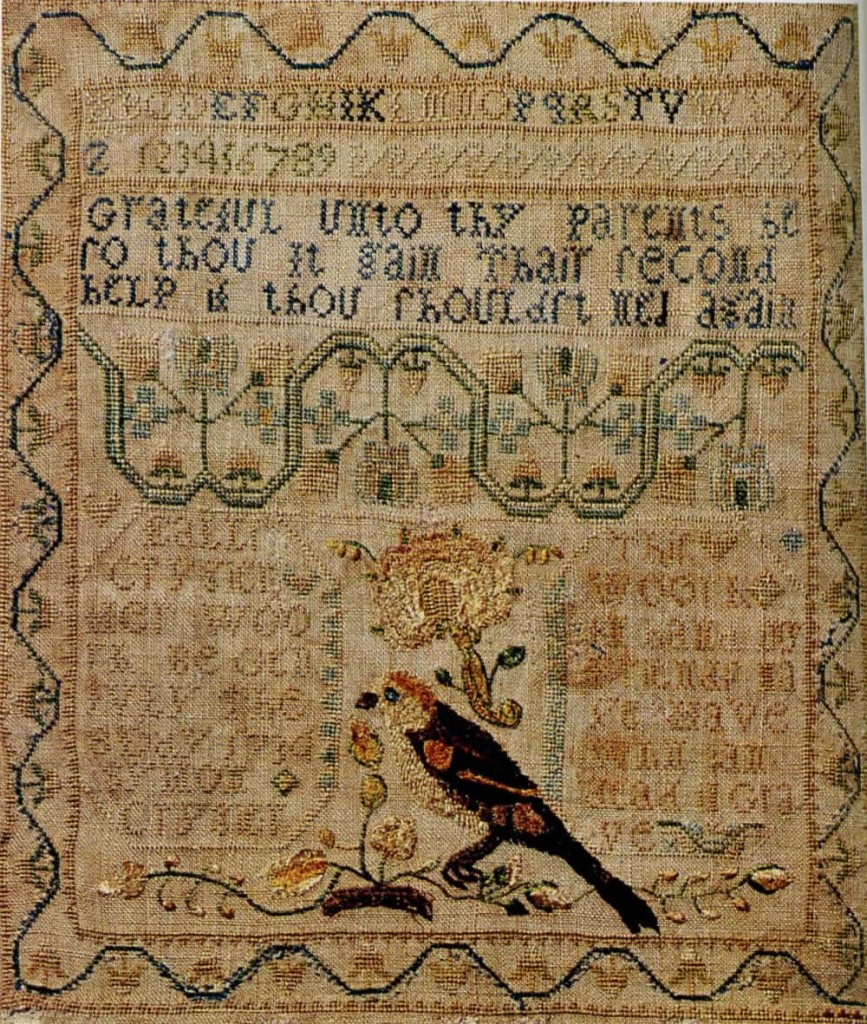

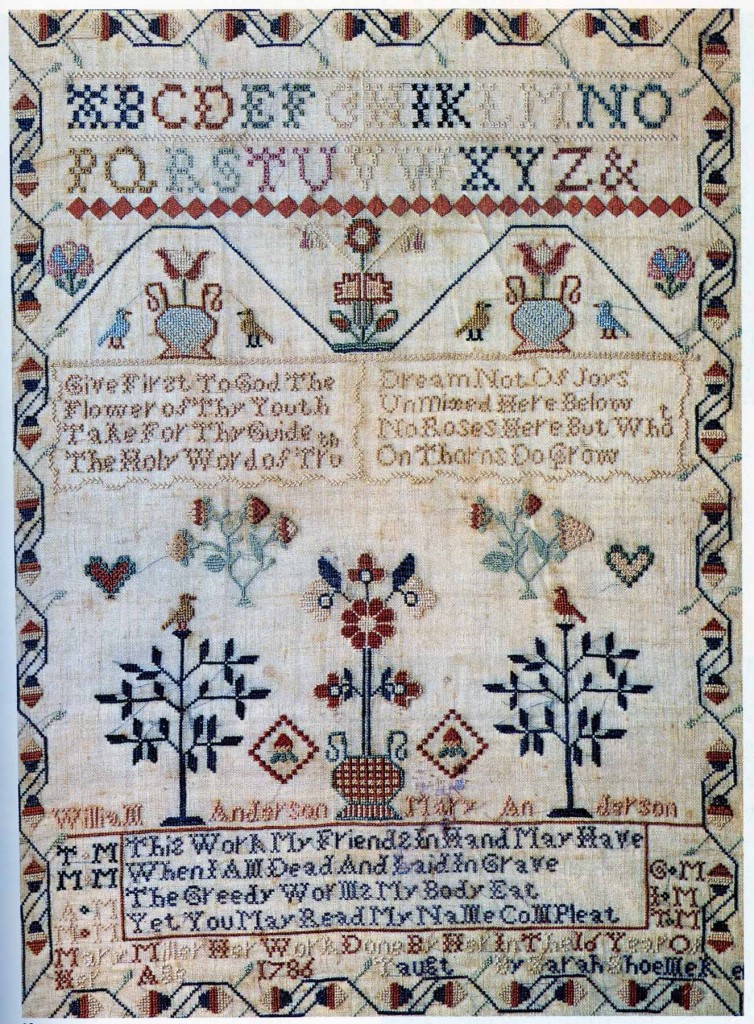
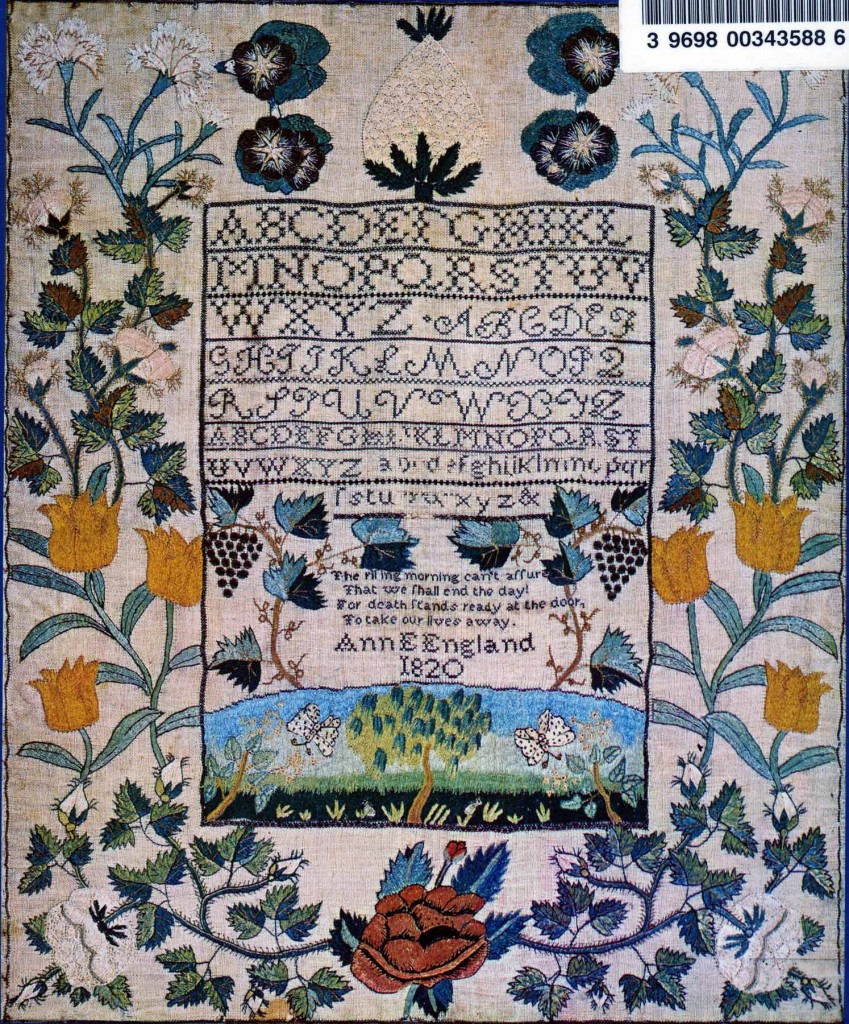
Comments
2 responses to “Needle-sharp Skills pt. I”
As History student, I enjoy reading your blog while I improve my english.
Keep on this way
Regards, Frank
Nice share that beautiful sharp skill this really amazing and creative too. Nice work